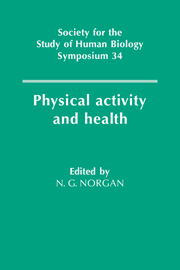Book contents
- Frontmatter
- Contents
- List of contributors
- Acknowledgements
- 1 Introduction
- 2 Comparative aspects of human activity
- 3 Physical activity levels – past and present
- 4 The validity of health measurements
- 5 Developments in the assessment of physical activity
- 6 Two national surveys of activity, fitness and health: the Allied Dunbar National Fitness survey and the Welsh Heart Health survey
- 7 Physical development and childhood activity
- 8 Physical activity and behavioural development during childhood and youth
- 9 Physiological aspects of activity and ageing
- 10 Activity and morale in later life: preliminary analysis from the Nottingham Longitudinal Study of Activity and Ageing
- 11 The benefits of low intensity exercise
- 12 Physical activity, obesity and weight maintenance
- 13 Adherence to physical activity and exercise
- 14 Women's working behaviour and maternal-child health in rural Nepal
- 15 Physical activity and psychological well-being
- 16 Leisure lifestyles: present and future
- Index
4 - The validity of health measurements
Published online by Cambridge University Press: 05 December 2011
- Frontmatter
- Contents
- List of contributors
- Acknowledgements
- 1 Introduction
- 2 Comparative aspects of human activity
- 3 Physical activity levels – past and present
- 4 The validity of health measurements
- 5 Developments in the assessment of physical activity
- 6 Two national surveys of activity, fitness and health: the Allied Dunbar National Fitness survey and the Welsh Heart Health survey
- 7 Physical development and childhood activity
- 8 Physical activity and behavioural development during childhood and youth
- 9 Physiological aspects of activity and ageing
- 10 Activity and morale in later life: preliminary analysis from the Nottingham Longitudinal Study of Activity and Ageing
- 11 The benefits of low intensity exercise
- 12 Physical activity, obesity and weight maintenance
- 13 Adherence to physical activity and exercise
- 14 Women's working behaviour and maternal-child health in rural Nepal
- 15 Physical activity and psychological well-being
- 16 Leisure lifestyles: present and future
- Index
Summary
What is health?
Health is a term that is widely used (for example, in the title of this symposium) but the underlying assumption that readers share a common understanding of its meaning is rarely justified (Seedhouse, 1986). Before the validity of health measurements can be discussed, the meaning of health must be clarified. A useful starting point is the definition of health included in the charter of the World Health Organization (WHO, 1946): ‘Health is a state of complete physical, mental and social well being and not merely the absence of disease or physical infirmity’.
As a statement of ideals it cannot be faulted, but it is doubtful that it describes an attainable goal and it does not offer a useful basis for measurement. A different definition is ‘Health is a state in which a person is enabled to work to fulfil their realistic chosen and biological potential’ (Seedhouse, 1986). From a practical point, this is much to be preferred, recognizing as it does that different individuals have different potentials. However, for purposes of measurement, it complicates things even further requiring not only the present state of each individual to be assessed but also their theoretical potential.
None the less, three important characteristics of health emerge from these definitions:
Disease is absent.
Other features (‘positive health’) are present.
The concept is multidimensional.
- Type
- Chapter
- Information
- Physical Activity and Health , pp. 28 - 44Publisher: Cambridge University PressPrint publication year: 1992

